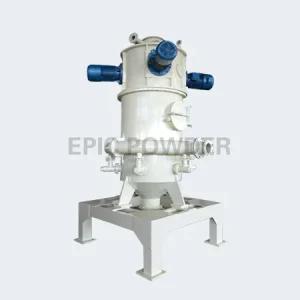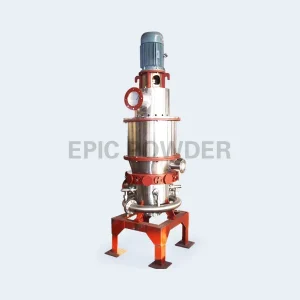In recent years, with the recognition of ultrafine particle superiority, more and more researchers have begun to attach importance to micro powder manufacturing research. Jet mill technology, an important method for preparing ultrafine powder, has become one of the preferred methods for developing high-performance micro powder materials.
Characteristics of jet mill
Jet mill, also known as airflow mill or jet pulverizer, is a machine that uses high-speed airflow to crush materials and impact components through collisions, impact, shear, and other effects.
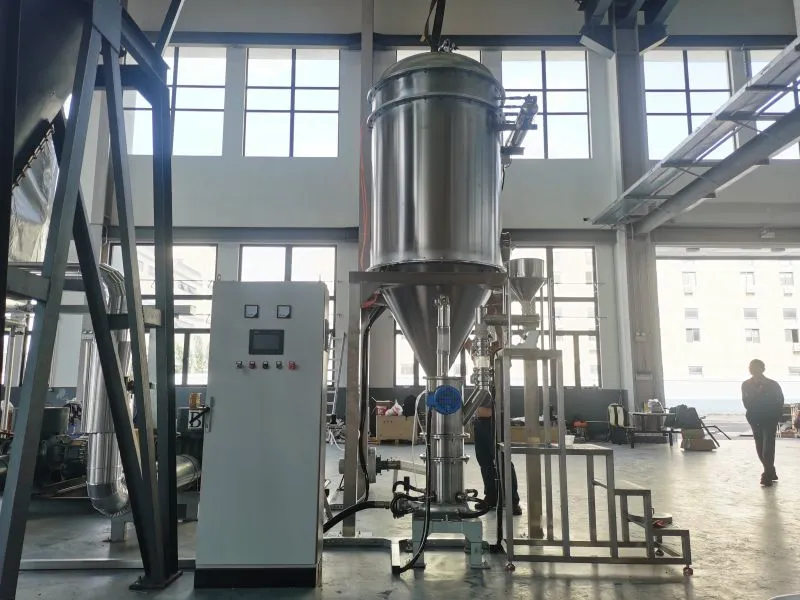
The product produced by crushing the material with an airflow mill has uniform fineness, a narrow particle size distribution, high purity, a smooth surface of particles, regular shape, and good dispersibility. The material is less contaminated during the crushing process, and can even have a pollution-free and sterile environment, making it suitable for ultra-fine crushing in fields such as food and medicine that do not allow external contamination. Airflow mills do n’t generate a significant amount of heat during the crushing process, making them more suitable for crushing materials with low melting points or thermal sensitivity compared to other crushing equipment. The production process is highly automated and can be applied to large-scale industrial production. Air flow pulverization can also facilitate joint operations of pulverization and subsequent production steps, such as simultaneously crushing and drying materials, or spraying solutions during pulverization to coat or modify the powder surface. However, there are drawbacks such as high energy consumption.
Application of jet mill
With many advantages, jet mills play an extremely important role in many fields.
Mining and metallurgy field
The application of jet crushing technology first originated in the field of mining and metallurgy, and there has been in-depth research in the preparation of ultra-fine metal or non-metallic powders. For example, it is widely used for the ultra-fine crushing of non-metallic minerals with medium hardness and below such as talc, marble, kaolin, mica, etc., as well as tungsten carbide powder, silver powder, tantalum carbide and other powders. In addition, in recent years, airflow crushing has begun to show new potential in material separation and solid waste recycling.
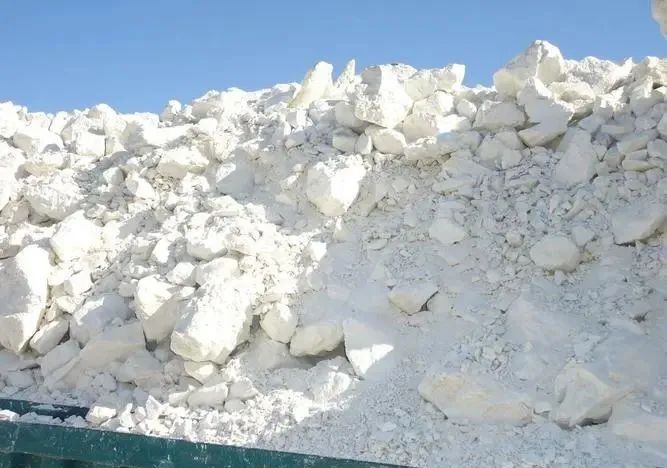
Military, aerospace and other fields
Ultrafine powder materials can be used to manufacture stealth materials for stealth aircraft, stealth tanks, etc. Rocket propellant made from products obtained by crushing and refining airflows such as oxidants and catalysts can more than double the burning speed of ordinary propellants.

Chemical industry, energy and other fields
As a pigment, titanium dioxide has high requirements on particle size and purity. Generally, a jet mill is used as a crushing equipment for titanium dioxide to meet the requirements. The titanium dioxide after jet crushing has better stability and optical properties. The catalytic performance of the aluminum hydroxide obtained after jet pulverization has been improved, and it can be used as a filler for artificial marble and fiberglass. In rubber production, the nano-zinc oxide obtained by airflow crushing has a good deagglomeration effect, and its dispersion in organic solvents has also been improved, which can effectively improve the vulcanization performance of natural rubber. In terms of energy, crushing and pre-treatment of straw affects the formation of fermentation scum, which is helpful for biogas fermentation, thereby improving the energy utilization of straw.
Medical field
The jet mill can crush common Chinese medicines such as ginseng, chrysanthemum, Panax notoginseng, wolfberry, forsythia, etc. It can crush the raw materials of Chinese herbal medicines to 1-5 μm, and the resulting medicinal powder has fine particle size, narrow distribution and low pollution, and has good dissolution and absorption of medicines. Very beneficial. In addition, it can also crush hard shellfish, bones and other medicinal materials.
Food field
Apple peels, citrus peels, wheat bran, corn husks, bean husks, rice bran, beet pulp, sugarcane bagasse, etc. are rich in vitamins and trace elements and have very good nutritional value. Not only do they not taste good when eaten directly, but the absorption effect is also poor. At a great discount, after being refined and processed by a jet mill, the taste and absorption can be significantly improved.
Cosmetics field
The colorant and filler powder are crushed by air flow and then added to liquid foundation and eye shadow to improve the compactness, adhesion and smoothness of the pressed powder. The andrographolide in skincare products is more water-soluble after being crushed by air flow, and can dissolve quickly while still maintaining antibacterial activity. The addition of VC powder and pearl powder after ultrafine grinding by airflow to skincare products will be more conducive to absorption.
Electronic field
Iron oxide ultrafine powder can produce high-performance magnetic materials. Silicon oxide ultrafine powder can produce high-performance resistive materials. Ultra-fine high-purity alumina powder can be used to manufacture sapphire substrates used in LED chips. Substrates made with ultra-fine powder have the characteristics of good stability, good light transmittance and no absorption of visible light. After the molybdenum powder is processed by airflow crushing technology, the particle size of the molybdenum powder becomes smaller, the particle size distribution becomes narrower, the morphology is uniform, and the bulk density and tap density are increased. It can be better used in the production of light bulbs, electronic tubes, integrated circuits, etc.
New energy field
The average particle size of the material after airflow crushing is fine, the particle size distribution is narrow, the particle surface is smooth, the particle shape is regular, the purity is high, the activity is high, the dispersion is good, and it meets the preparation requirements of electrode materials, so it is widely used. Typical materials suitable for jet pulverizer are: lithium manganate, lithium cobalt oxide, lithium iron phosphate, lithium carbonate, spherical graphite, petroleum coke, asphalt coke, ternary materials, nickel metal hydride alloy, ferrous oxalate, lithium titanate, nickel Lithium manganate, etc.

Classification of jet pulverizer
Since the American Fluid Energy Company developed the world’s first jet pulverizer (jet mill) in 1934, its structural form has been continuously updated and developed. Currently, jet pulverizers can be divided into: Flat airflow pulverizer, counter-jet airflow pulverizer, target airflow pulverizer, circulating tube airflow pulverizer, fluidized bed airflow pulverizer.
Fluidized bed jet pulverizer
Fluidized bed airflow mill is a new type of airflow mill that has the advantages of narrow particle size distribution, high crushing efficiency, low energy consumption, low product pollution, and low accessories wear, but the equipment cost is high. Since the material needs to be fluidized before it can be crushed by the collision of the air jet, the fluidized bed airflow mill usually requires that the material to be crushed needs to be of sufficient fineness, and the requirements are more obvious for materials with high density. It is often used for ultra-fine crushing, breaking up and shaping of materials in synthetic resin, phenolic resin, medicine, cosmetics, advanced ceramics, magnetic powder, battery materials and other industries.
Flat jet pulverizer
Flat airflow pulverizer, also known as horizontal disc airflow mill, is the earliest and most widely used airflow pulverizer in industry. It has the advantages of simple structure, easy operation, self-grading, etc. However, the impact kinetic energy of the equipment is small and the crushing intensity is low. When processing materials with higher hardness, the inner wall of the machine body will produce violent vibrations between the material and the inner wall of the grinding chamber due to the action of the material along with the high-speed air flow. Collision and friction will aggravate the pollution of the grinding cavity and cause certain pollution to the product. It is suitable for a wide range of materials, especially materials composed of various aggregates or condensates.
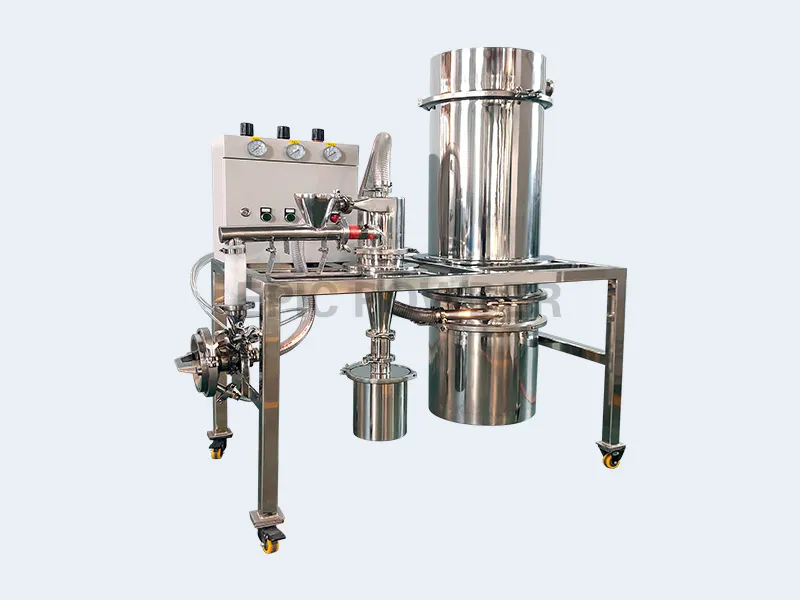
Counter-jet jet pulverizer
The counter-jet airflow mill, also known as the counter-jet airflow mill and reverse jet mill, is a piece of equipment with high energy utilization. Since the crushing process mainly relies on high-speed collisions between particles, it can effectively avoid the wear of impact parts by high-speed airflow, and at the same time improve the problem of material contamination, and the product particle size is also finer; however, the equipment occupies a large area, has high energy consumption, and has poor particle size distribution. wider. It is often used to crush hard, brittle and sticky materials.
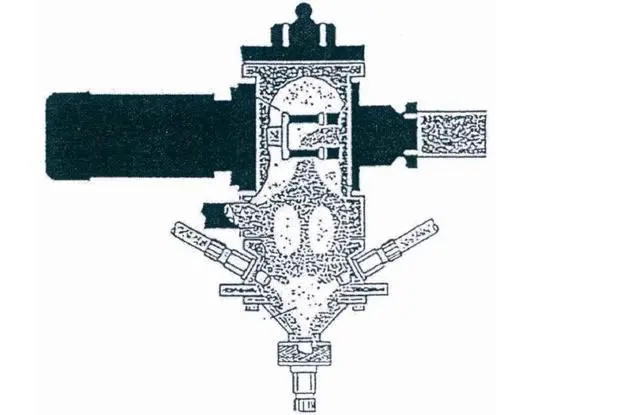
Target jet mill
Target jet mill is also called single jet mill. The feeding direction has good adjustability, large crushing force, and can handle materials with relatively high toughness; however, the target plate and mixing tube of the equipment are prone to wear and serious erosion, so parts need to be replaced regularly, which may contaminate the material to a certain extent, resulting in poor product particle size. The distribution is wider and the kinetic energy consumption is larger. It is often used to crush high molecular polymers, low melting point heat-sensitive, and fibrous coarse materials.
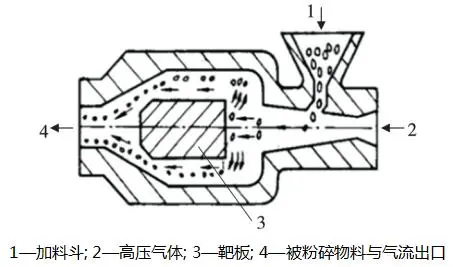
Circulating tube airflow pulverizer
The circulating tube airflow mill (vertical annular jet airflow mill) has the advantages of small particle size distribution, no power device, not easy to pollute, and the material is not easy to stick to the wall; however, this type of equipment has low crushing efficiency, high energy consumption, and inner wall wear. serious. It is often used for crushing brittle and low-hardness materials. It is usually divided into equal circular cross-section and variable cross-section circulating tube types according to the cross-section.
There are many types of ultra-fine airflow crushing equipment, and the structure of each type of equipment also has obvious differences, and each has corresponding advantages and disadvantages. In the future, the mainstream development trend of ultra-fine airflow crushing equipment will be mainly reflected in increasing the output of a single machine and reducing the energy consumption per unit product; improving product fineness and strengthening the crushing limit of the equipment; and online control of product fineness and particle size distribution.

